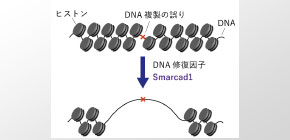
Mechanisms of DNA mismatch repair unraveled
Will lead to the prevention of cancer development
Precise replication of chromosomal DNA is critical in cell reproduction. Errors in this process, if left unrepaired, can cause mutations in genetic information, which can eventually lead to the formation of tumors and other genetic diseases. This is one reason why living organisms are equipped with a mismatch repair (MMR) system, which is critical for suppression of these mutations in DNA. But DNA packaging is complex. DNA is folded into the nucleus by specialized proteins, called histones, which act as the spools around which DNA is tightly wrapped. How, then, do proteins access this DNA when a copying error needs to be fixed? This problem has long been a mystery.
Dr. Tatsuro Takahashi, Associate Professor at the Faculty of Science, Kyushu University, and technical assistant Mr. Riki Terui, along with a team of researchers that include Professor Hisao Masukata from Osaka University and Professor Seiji Tanaka from Kochi University of Technology, now have some answers. Their team has clarified the repair mechanism of DNA copying errors through in vitro reconstitution studies and discovered that the MMR system essentially unravels the DNA from histones at the site of a copying error. Furthermore, they have identified a protein called Smarcad1 as a factor that aids in the exclusion of histones from mismatch-carrying DNA. The new findings reveal for the first time how the mechanisms of DNA packaging interact with the MMR system.
The MMR system is linked to the prevention of cancer development, the formation of immune system diversity, and the effectiveness of certain types of anti-cancer drugs. The new findings not only advance the understanding of basic genome maintenance mechanisms, but may also open doors to future medical research on cancer treatment and immune response related to deficient DNA mismatch repair.

Figure 1 . When an error occurs during DNA replication, repair factors and newly identified protein Smarcad1 unravel the histones that surround the mismatch-carrying DNA.
To learn more, see the original article as published in Genes & Development:
“ Nucleosomes around a mismatched base pair are excluded via an Msh2-dependent reaction with the aid of SNF2 family ATPase Smarcad1 .” Genes & Development, 2018, 32, 806–821.
Related link
